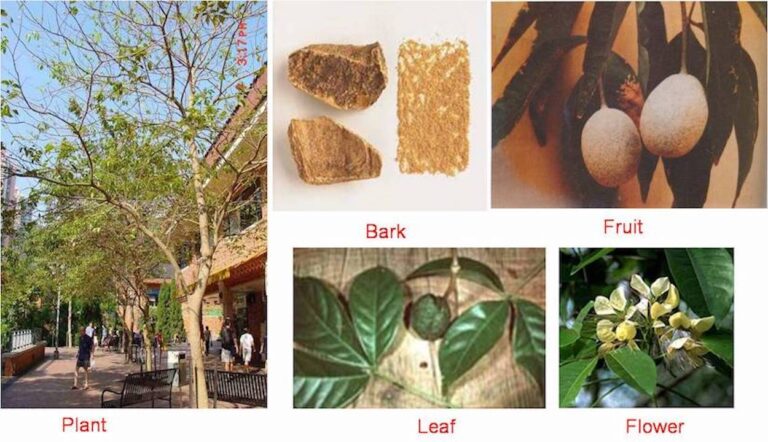VARUNA
A renowned plant for the treatment of diseases related to Urinary system in Ayurveda is Varuna. It is mentioned in different group enumerated in Sushruta Samhita. The plant has found its place as an ingredient in many formulations of Ayurveda that are being used even today. The species that is being accepted as Varuna officially is Crataeva nurvala Buch-Ham belonging to the family Capparidaceae. This plant is also known by the name Crateva nurvala F. Ham., The plant is commonly seen in South Asia especially in the Indo-malaysian zone where there are dry deciduous forests. It is also planted commonly in gardens and along avenues in Central and Northern parts of India. The word Crataeva is named on the honour of the botanist who lived during the time of Crates, while the word nurvala is derived from the Malayalam word “Nir” which means water. The plant is planted or cultivated near water sources of temples or river banks.
PLANT DETAILS
BOTANICAL NAME
Crataeva nurvala Buch-Ham.
FAMILY
Capparidaceae
NOMENCLATURE
VERNACULAR NAMES
- Kannada – Narumbele
- Malayalam – Nirvala
- Tamil – Maralingam
- Telugu – Urumetti
- Hindi – Baruna
- English – Three leaved caper
SANSKRIT SYNONYMS
- अमृत (Amruta) – Is beneficial like nectar and postpones ageing
- धात्री (Dhatri) – is mother or foster-mother in Sanskrit. Hence the fruit takes care of us like mother
- श्रीफल (Shriphala) – Highly beneficial fruit
- शीत (Sheeta) – Has a soothing potency
- त्रिष्यफल (Tishyaphala) – The fruit is demarcated with three lines
- आमलक (Amalaka) – A sour tasting fruit
- शिव (Shiva) – A very auspicious and favourable
SAMHITA CLASSIFICATION
- Charaka Samhita – None
- Sushruta Samhita – वरुणादि (Varunadi), वातसंशमनादि (Vatasamshamanadi) & कफाश्मरिनाशक (Kaphashmarinashaka).
NIGHANTU CLASSIFICATION
- Dhanvantari Nighantu – Amradi Varga
- Bhavaprakasha Nighantu – Vatadi Varga
- Raja Nighantu – Prabhadradi Varga
- Kaiyadeva Nighantu – Aushadhi Varga
BRIEF MORPHOLOGY
An erect or crooked deciduous trees branching high above the ground. The bark is rough and has grey or greyish brown outside while whitish brown or pale inside. Leaf petiole is with a distinctive knob consisting of glands, trifoliate, midrib reddish tinged nerves are prominent beneath. Inflorescence is terminal corymb bearing prominent scars on the petiole with whitish cream, pale yellow or reddish yellow coloured flowers that are fragrant also. Fruits are berry covered with yellow greyish or deep orange crust, spherical or oval, hard, slim with multiple reniform seeds embedded in an yellow fleshy pulp.
PHARMACOGNOSY OF OFFICIAL PART
MACROSCOPY
YET TO BE COMPILED
MICROSCOPY
YET TO BE COMPILED
PART USED AND POSOLOGY
PART USED
त्वक् (Bark), पत्र (Leaves), मूल (Roots)
DOSE
क्वाथ (Decoction) – 50 to 100ml.
PHYTOCHEMISTRY
The plant contains alkaloids, flavanoids, phytosterols, saponins, phenolics, tannins, triterpenoids and volatile oils. The stem bark contains betulinic acid, catechin, acetyl alcohol, diosgenin, friedelin, gluco-capparin, lupeol, β-sitosterol, cadabicine diacetate and cadabicine mether.
रसपञ्चक कर्म PROPERTIES AND USES AS PER AYURVEDA
गुण (Properties)
- रस (Rasa) – तिक्त (Tikta), कषाय (Kashaya)
- गुण (Guna) – लघु (Laghu), रूक्ष (Ruksha)
- वीर्य (Veerya) – उष्ण (Ushna)
- विपाक (Vipaka) – कटु (Katu)
- प्रभाव – None
कर्म & प्रयोग (Action & Indications)
- दोषकर्म (Doshakarma) – कफपित्तशामक (Kaphapittashamaka) पित्तवर्धक (Pittavardhaka)
- धातुकर्म & मलकर्म (Dhatukarma and Malakarma) – Main actions – भेदन, दीपन, कृमिघ्न, मूत्रल & अश्मरिघ्न(Bhedana, Deepana, Krimighna, Mutrala & Ashmarighna)
- Other Actions – रक्तशोधक, वर्ण्य, ज्वरघ्न, अर्शोघ्न, पि्त्तसारक (Raktshodaka, Varnya, Jwaraghna, Arshoghna, Pittasaraka)
- प्रयोग (Prayoga) – Mainly कृमि, वातरक्त, मूत्राघात, गुल्म, अश्मरि (Krimi, Vatarakta, Mutraghata, Gulma, Ashmari) also useful in बस्तिशूल, व्रणशोथ, व्रण, गण्डमाला, गलगण्ड, मेदोरोग, अर्श, व्यङ्ग, रक्तदोष, वर्णविकार, दौर्बल्य, ज्वर, विद्रधि, etc (Bastishula, Vranashotha, Vrana, Gandamala, Galaganda, Medoroga, Arsha, Vyanga, Raktadosha, Varnavikara, Daurbalya, Jwara, Vidradi, etc)
AYURVEDIC FORMULATIONS
CLASSICAL
- Varunadi Kwatha
- Varunadya Taila
- Varunadya Ghrita
- Varunaksharayoga
- Varunadya Churna
PROPRIETARY
- Varuna Tablets
AGRONOMY
ENVIRONMENT
NOT YET COMPILED
CULTIVATION
NOT YET COMPILED
HARVESTING
NOT YET COMPILED
STORAGE
NOT YET COMPILED
VARIETIES AND SUBSTITUTES OR ADULTERANTS
VARIETIES
General classification it is of two types namely
- वन्य (Wild)
- ग्राम्य (Cultivated)
ADULTERANTS
NO KNOWN ADULTERANTS
SUBSTITUTES
NO KNOWN SUBSTITUTES
TOXICITY
TOXIC SYMPTOMS
- As such there is no proved toxicity of the plant.
ANTIDOTE
- Not Applicable as such.
शोधन or PURIFICATION METHOD
- NOT NECESSARY
THERAPEUTIC USES
EXTERNAL USES –
Paste of fresh leaves is prepared with hot water and applied over the effected place like soles to relieve pain and swelling. The leaf juice along with coconut milk and ghee is mixed together and applied on the affected part to treat Rheumatism. The paste of bark is also applied on the affected part to treat Abscess, inflammatory conditions, etc. Bark powder is applied on the skin to treat inflammation, abscess and lymphadenopathy. The paste of leaf is applied over forehead to reduce giddiness in fever.
INTERNAL USES –
Internally the decoction of the bark is given to treat urinary diseases. The decoction prepared from bark is also used internally to treat Renal calculus. The bark is added with the bark of Kanchanara (Bauhinia variegata Vahl) to prepare a decoction and given internally to treat Gandamala (Cervical Lymphadenopathy). Decoction of leaves are is given internally to treat fever.
CONTROVERSY (IF PRESENT)
YET TO BE COMPILED
LIST OF RESEARCH STUDIES
- Kumar, D., Sharma, S. & Kumar, S. Botanical description, phytochemistry, traditional uses, and pharmacology of Crataeva nurvala Buch. Ham.: an updated review. Futur J Pharm Sci 6, 113 (2020).
- Nishritha Bopana & Sanjay Saxena (2008) Crataeva nurvala: A Valuable Medicinal Plant, Journal of Herbs, Spices & Medicinal Plants, 14:1-2, 107-127,
- Babbar, S.B., Walia, N., Kaur, A. (2009). Large-scale In Vitro Multiplication of Crataeva nurvala. In: Jain, S.M., Saxena, P.K. (eds) Protocols for In Vitro Cultures and Secondary Metabolite Analysis of Aromatic and Medicinal Plants. Methods in Molecular Biology, vol 547. Humana Press, Totowa, NJ.
The video on Varuna emphasises on the various aspects of the plant especially with respect to its cultivation and its characteristics for identification such that they are preserved for the future generations.



